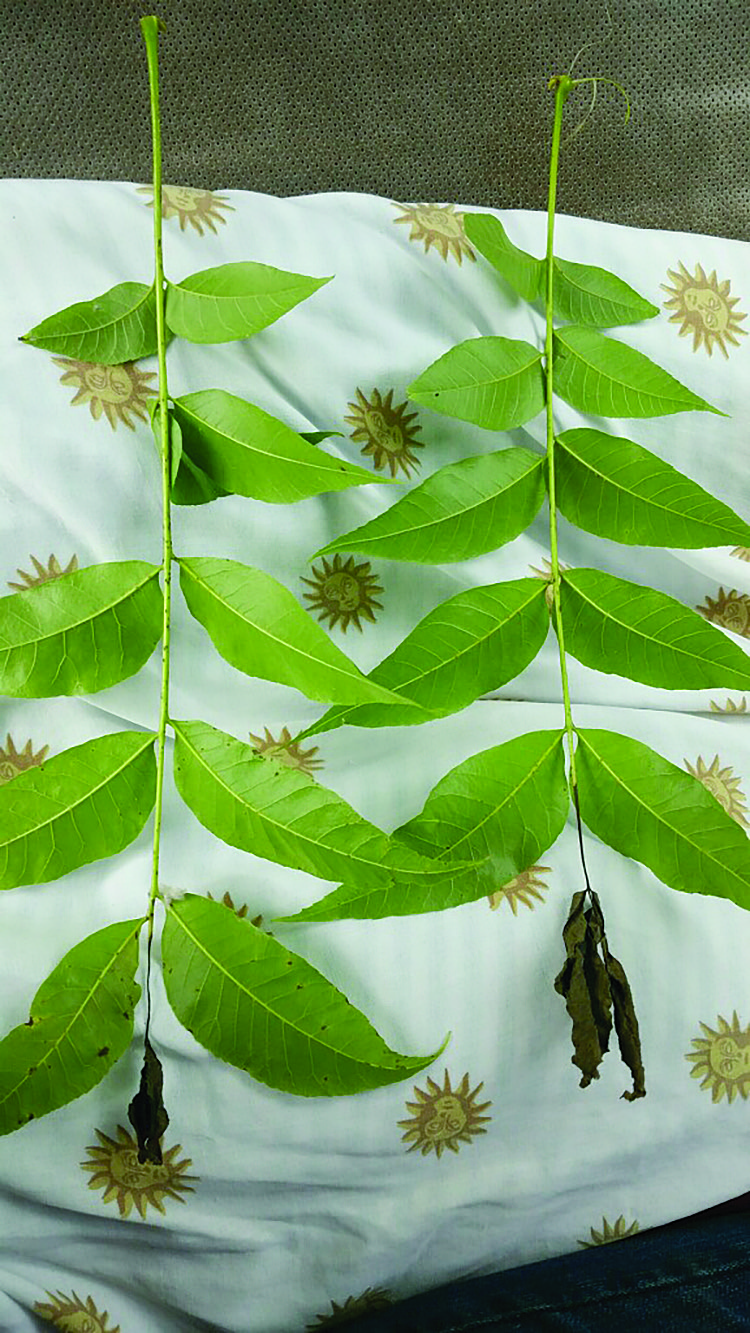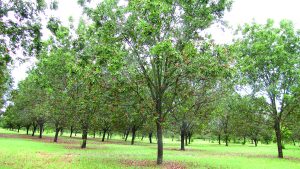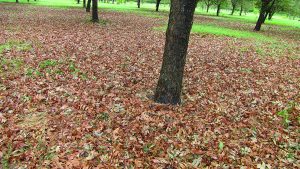Dormant-Season Disease Prevention

Leaflets turning brown, later progressing to death of entire compound leaf and leaf drop. (Photo by Monte Nesbitt)
Gone are the days of hand preparing “Bordeaux Mixture”, a 19th Century, man-made fungicide, concocted of copper sulfate and slaked lime that would stain a person’s skin blue. Gone also are the days of spraying from the back of a truck or wagon with a hand wand.
Yes, pecan fungicides are expensive, and yes, they can have resistance problems, but they generally work well enough (in normal weather years) for management of scab, downy spot, powdery mildew and other foliage and fruit diseases to be accomplished during the growing season. If there’s a problem though today, it may be that the southeastern pecan industry is increasingly reliant on synthetic fungicides. Pecan growers have moved away from some ‘old time’ practices that may still have merit — sanitation and dormant-season sprays for disease management.
In annual row crop or vegetable farming, plants are harvested or plowed under at the end of the season, and months of time elapse with no plants present in the field. It’s a beautiful system for breaking plant disease cycles, which depend on spores, fungal strands, or bacterial colonies — usually attached to some plant tissue or organ and the onset of proper weather conditions to repeat the war on plants. Removing the inoculum means that spores or bacterial cells must be reintroduced to the field site by wind, dust, surface water flow, insects or new plants.
In contrast, an orchard of pecan trees is a beautiful system for perpetuating plant disease cycles. Spores or other fungal structures readily survive the dormant period on pecan shucks, limbs and dried leaf litter, thus there is little to no time lapse in the spring before disease inoculum ramps back up to a high level. As trees age, crowd one another and get taller, more overwintering inoculum is present, meaning ever-increasing disease pressure during the growing season.
Orchard sanitation is a vague term for keeping an orchard as clean as possible to reduce factors that contribute to disease pathogen and/or insect buildup. A 1932 USDA Technical Bulletin on pecans by Jones et al. described it as “knocking off scab-infested leaves and nut shucks in the winter, disposing of girdled twigs and limbs, destroying webworms, etc.” Sanitation was important in that era of pest and disease management when fewer effective chemicals were available. Essentially a grower did everything he or she could to limit their exposure to a pest or disease.
Sanitation is still recommended as a commercial orchard practice for disease and insect control today. A Washington State University tree fruit production website states the following about orchard sanitation: “Fungal pathogens over-winter on dried leaves, pruned limbs, and decaying fruit on the orchard floor. Fungal spores produced on the leaves and limbs left on the orchard floor can inoculate healthy trees and fruit in the spring when temperatures are warm and rain, irrigation water and wind spread the spores. Diseased branches that have been pruned need to be disposed of as soon as possible. Flail mowing of limbs and leaves on the ground will break them down more quickly and decrease fungal inoculum. Dr. George Sundin, Michigan State University, recommends urea treatments in the fall or spring, as the nitrogen speeds up the break- down of the leaves where Apple scab overwinters.”
Recommendations for orchard sanitation never pretend for it of itself to be a means of completely eliminating diseases or insects in orchards, but rather act as a contributing factor toward better overall control. Demaree (1924) stated that pecan orchards that inadvertently experienced fires sweeping across the orchard floor also had little problem with pecan scab that same year; justification of his recommendation for good sanitation practices.
Dormant (mid-winter) or delayed-dormant (late winter to early spring) spraying of trees for disease and insect management carries this same objective of orchard sanitation. Certain chemical compounds sprayed on to fungal spores or overwintering insects can kill or render them unviable. Dormant and delayed dormant spraying is recommended widely in fruit and nut orchards and vineyards, having direct control benefits on some diseases and little effect on others. As an example, a University of California recommendation for Peach Leaf Curl fungal disease states: “To prevent peach leaf curl in areas where the disease occurs, treat susceptible trees with preventive fungicides during the dormant season, ideally in late November or December. A second application should be made in late winter or early spring just before buds swell.”
Also, notice the following UC recommendation: “Unlike peach leaf curl, treatments for apple and pear scab made when trees are completely dormant aren’t effective and aren’t recommended. If treatments are needed, the generally recommended time is between when buds begin to break and a month after petal fall.”
These examples show both benefit and failure of dormant sprays for disease control. Despite the best effort to sanitize the orchard and trees in the orchard, some diseases are going to be a problem during the growing season if conditions favor disease infection. Pecan scab should be considered in that category, its spores having great capacity to move long distances and reproduce quickly. Dr. Tim Brenneman and co-workers (2015) have reported possible benefits to pecan disease control from dormant season fungicide sprays in a preliminary study conducted in 2014.
Pecan scab is the most important, but not the only economically significant, pecan disease. Growers in the Southeast can sustain premature defoliation from Downy spot, which overwinters in fallen leaves. Leaf blotch, zonate leaf spot, vein spot are other potential problems. In 2015, a new foliage disease problem appeared in Texas orchards from Bastrop County and eastward, presumably resulting from unusually high rainfall experienced in May and June. In July and August, we began receiving reports of unusual leaf browning and defoliation.
Growers observed terminal leaflets turning brown or black as early as May (Fig. 1), progressing to cause death of the entire compound leaf and leaf drop from June to August. Some orchards had very high levels of defoliation and dieback of terminal shoots (Fig. 2). While the Texas A&M Plant Disease Clinic in Texas was not successful at isolating the pathogen, the same problem has been identified in Georgia by Dr. Tim Brenneman as the fungus Neofusicoccum sp. The common named being used for it in Georgia is “terminal dieback” (Wells, Pecan South, Feb., 2016).

Some orchards, right, had very high levels of defoliation and dieback of terminal shoots. (Photo by Monte Nesbitt)
‘Pawnee’ was the worst-affected variety observed in Texas, while Dr. Charlie Graham at LSU reported problems on ‘Pawnee’ and ‘Elliott’. The disease should be controlled by DMI/strobilurin combinations during the growing season, according to Brenneman, but because of the shoot dieback observed in some orchards in Texas, it may be helpful to use dormant or delayed-dormant sprays to try to reduce the inoculum before the growing season begins.
What products can be used for dormant or delayed dormant disease management? Horticultural oils, including supreme oils, superior oils and dormant oils are recommended during dormancy for scale insect control in pecan orchards (Ree, Pecan South, Jan. 2014). These petroleum-based products are known to have some disease control effects as well, particularly in citrus, bananas, and against powdery mildew on several crops. While there are no known benefits for disease prevention in pecans, it is worth mentioning that oils may be a positive contributor to integrated insect and disease management when applied during dormancy.
Bordeaux Mixture, as mentioned above, was the first important fungicide for combatting pecan scab and other diseases. Its fungicidal properties are derived from copper ions in the mixture. Soluble copper ions are absorbed by fungal spores, causing protein breakdown and blocking of enzyme synthesis of those spores, so it is a good fungicide if present in soluble form. When sprayed on trees, Bordeaux is also quite rain-fast. Unfortunately, it is highly corrosive to spray equipment, causes excess copper accumulation in soil and is fairly toxic to humans, fish and livestock. It has to be mixed at the right proportions of copper sulfate to lime in order to not be phytotoxic to pecan foliage.
Fixed or neutralized forms of copper, including basic copper sulfate and copper hydroxide, are less corrosive, toxic, and rain-fast, yet less water soluble and fungicidal than Bordeaux. In theory, they could provide some orchard sanitation during the dormant, late dormant or early budbreak periods, although there are no studies to support their use for that purpose.
Several commercial products are labeled for pecans. Many copper hydroxide (Kocide) products are labeled for growing season application for shuck and kernel rot of pecans, as well as zonate leaf spot control. They may also carry a label for control of Spanish or ball moss, which some growers like to control during the dormant period. Similarly, basic copper sulfate products are manufactured by a variety of companies, with labels for pecans in many cases. Not of these fixed coppers are phytotoxic to pecan foliage, and thus can be applied to leaves during the growing season. For growers whose trees are deficient in copper (<6 ppm in July leaf samples), these products are the typical choice for correction. Over-application of copper should be avoided, because excess soil levels can inhibit root growth and alter soil microflora composition.
Liquid lime sulfur (Calcium polysulfide), made by boiling quicklime and sulfur together in water, was a very widely used orchard sanitation product from the late 1800s through the 1930s. It has fungicidal and insecticidal properties. It is highly alkaline and can burn skin of mixer/handlers as well as fungal spores and even foliage on most plants. Thus its use has always been for sanitation and pest prevention during the dormant months. Commercial products are available today and it is recommended in many orchard crops for dormant or delayed dormant sprays to reduce fungal and bacterial inoculum. Thorough and liberal coverage of limb, twig and trunk surfaces is required for lime sulfur to give benefits in reducing inoculum load on trees.
People frequently inquire about the use of common disinfectant chemicals like sodium hypochlorite (bleach) and hydrogen peroxide for “cleaning” trees of fungal inoculum. Bleach is used in seed sterilization and postharvest sanitation and disease suppression of fruits and nuts. Hydrogen peroxide has demonstrated sporicidal properties in lab culture studies. Both bleach and hydrogen peroxide are not stable once sprayed into open-air environments. Temperature, water, sunlight and soil have degradation effects, depending on the product. Some pecan growers in Alabama were using bleach during the growing season to improve scab control in the 1990s, but in controlled studies, we could find no benefit.
Crystal balls would be useful in the pecan business. In February and March, we have little means of predicting what type of growing season will be encountered in 2016. Orchard sanitation practices, including care of the orchard floor, pruning and burning limbs, and spraying of trees to reduce inoculum offer subtle improvements or enhancements to disease and insect control. If we could forecast that 2016 would be an average rainfall year, we could also predict that the benefits of these extra winter and spring measures would probably be minimal. If on the other hand, we had the benefit of knowing that disease pressure in 2016 would be unusually high and the crop set good, that extra effort and expense on sanitation might seem like a bargain.


